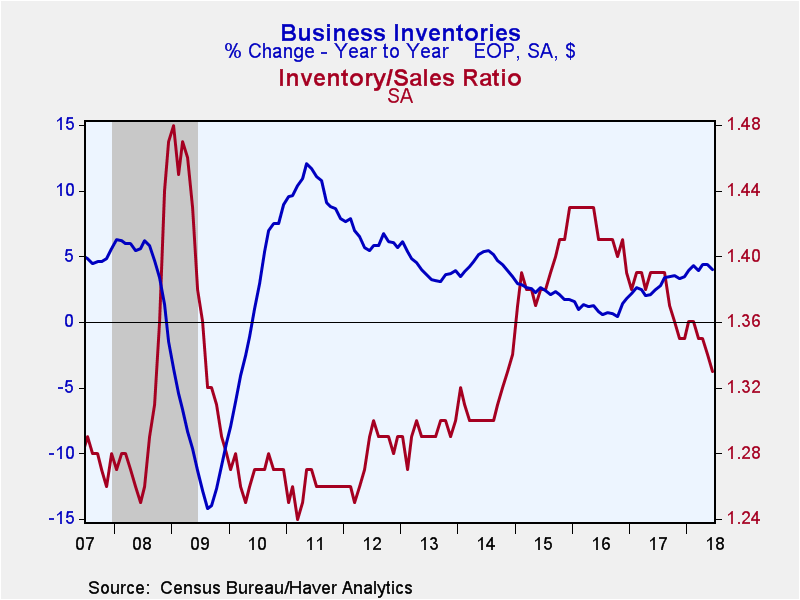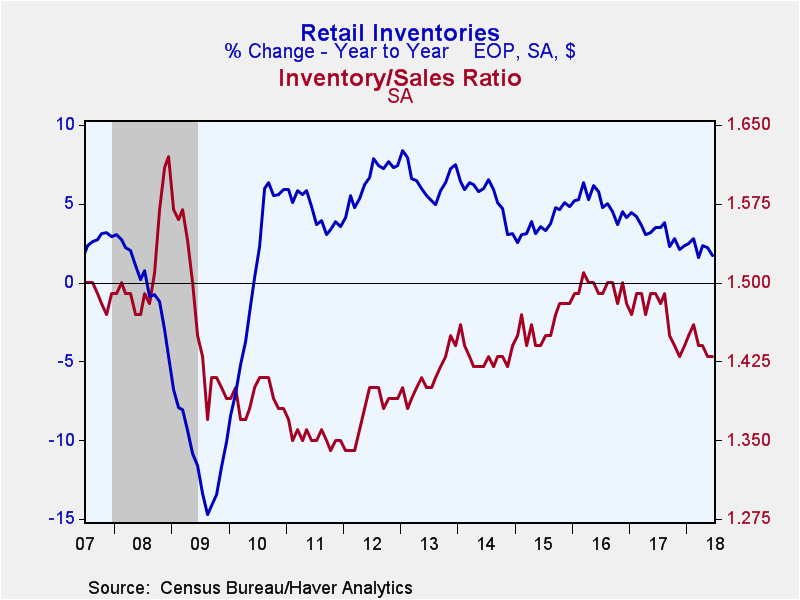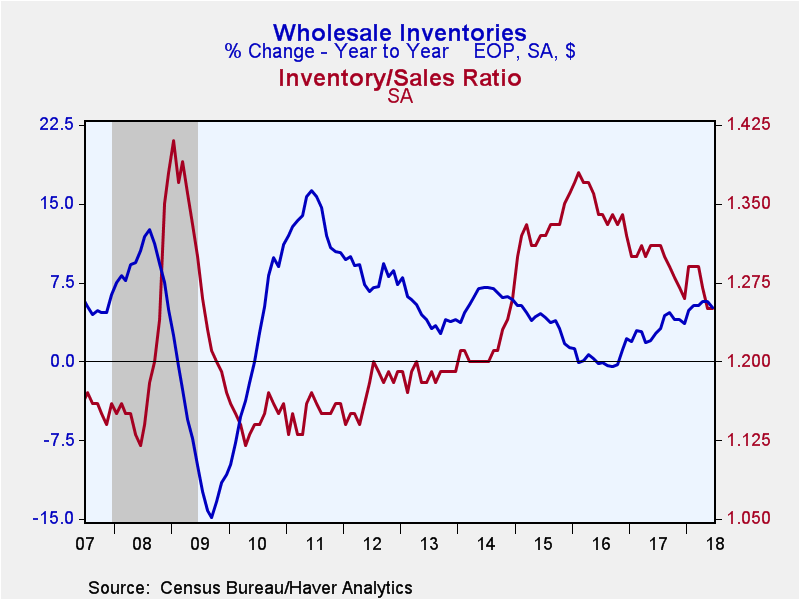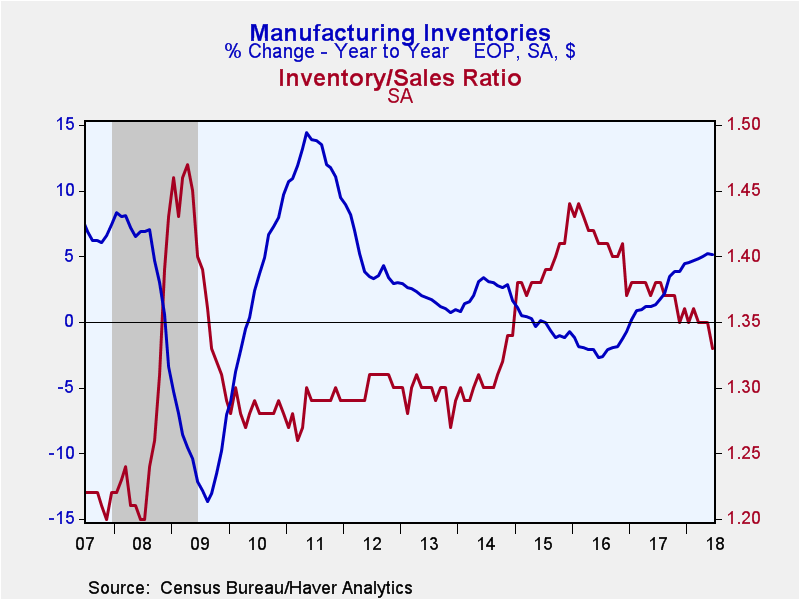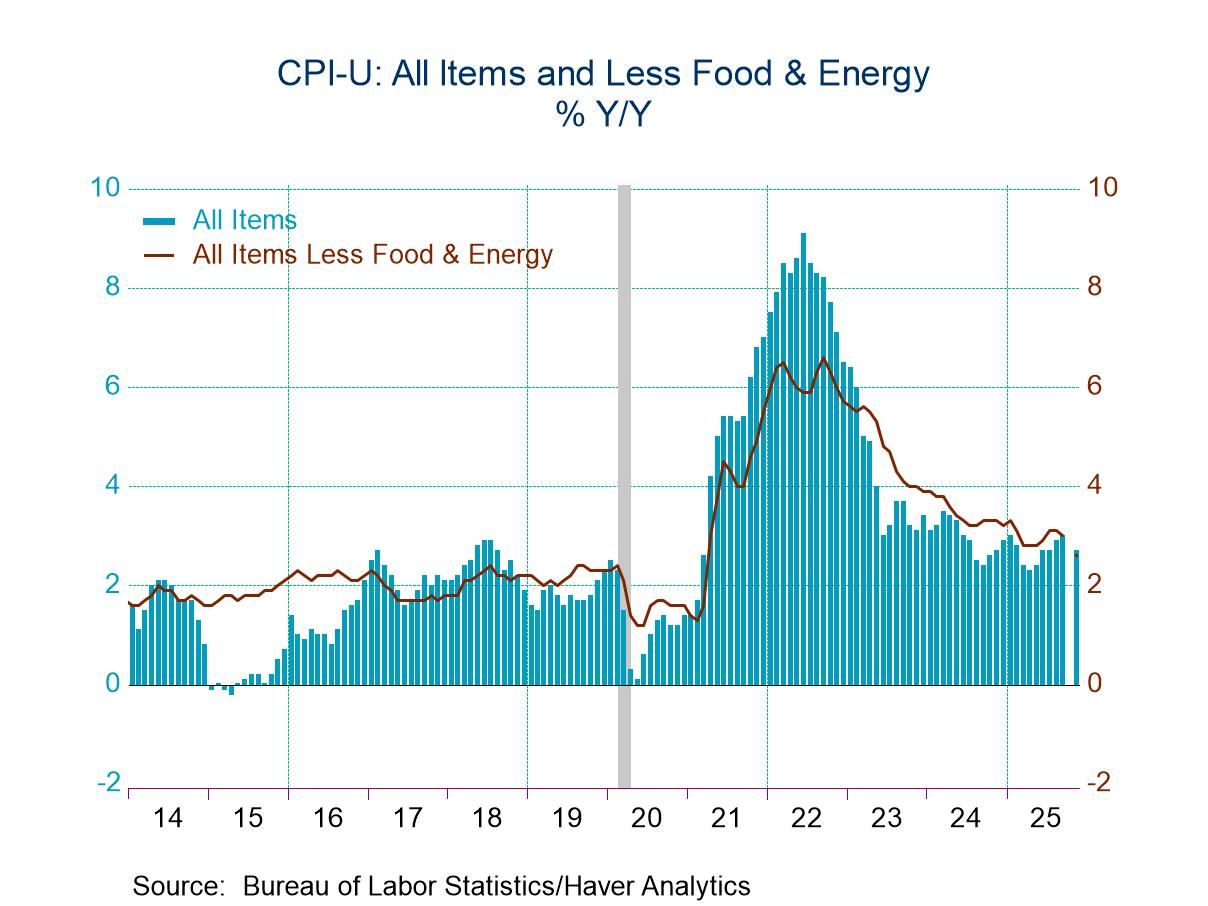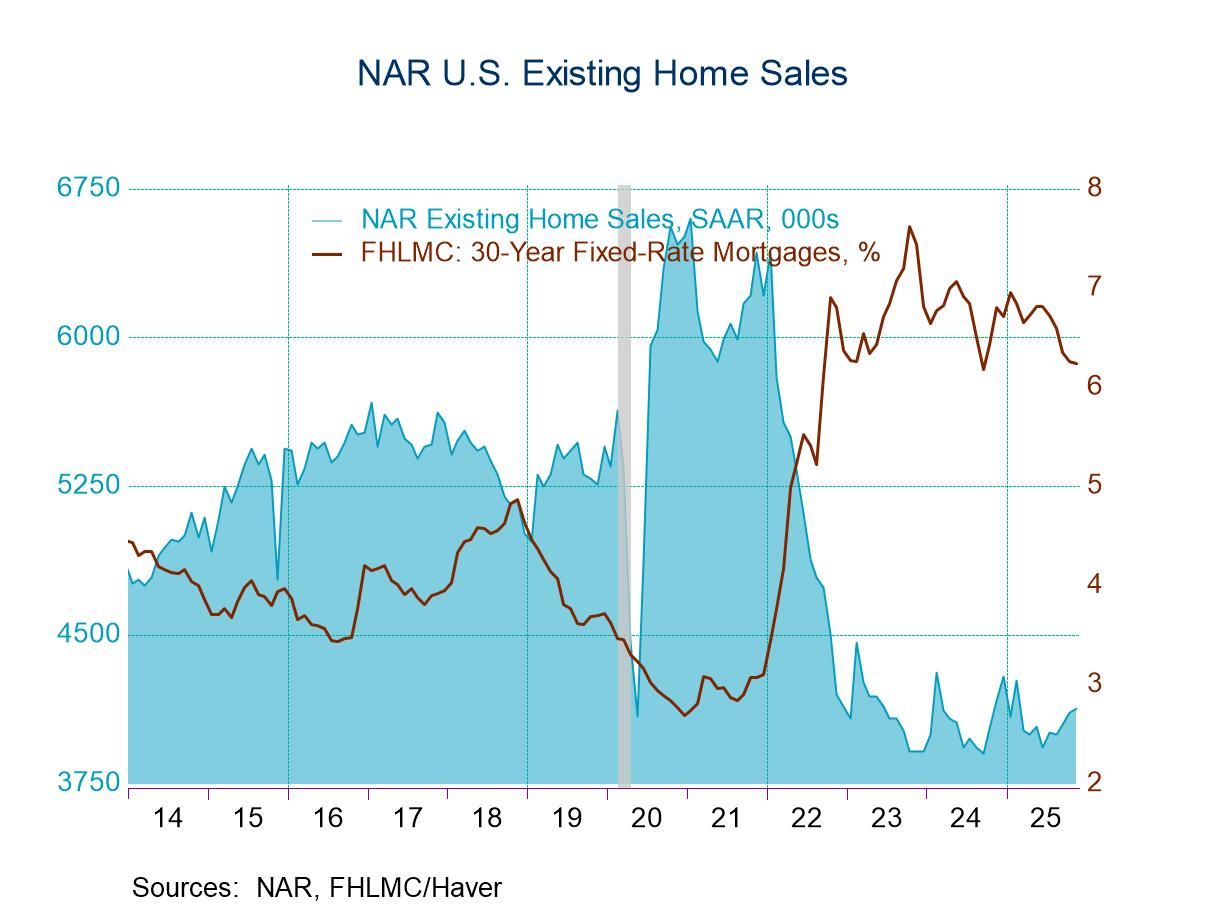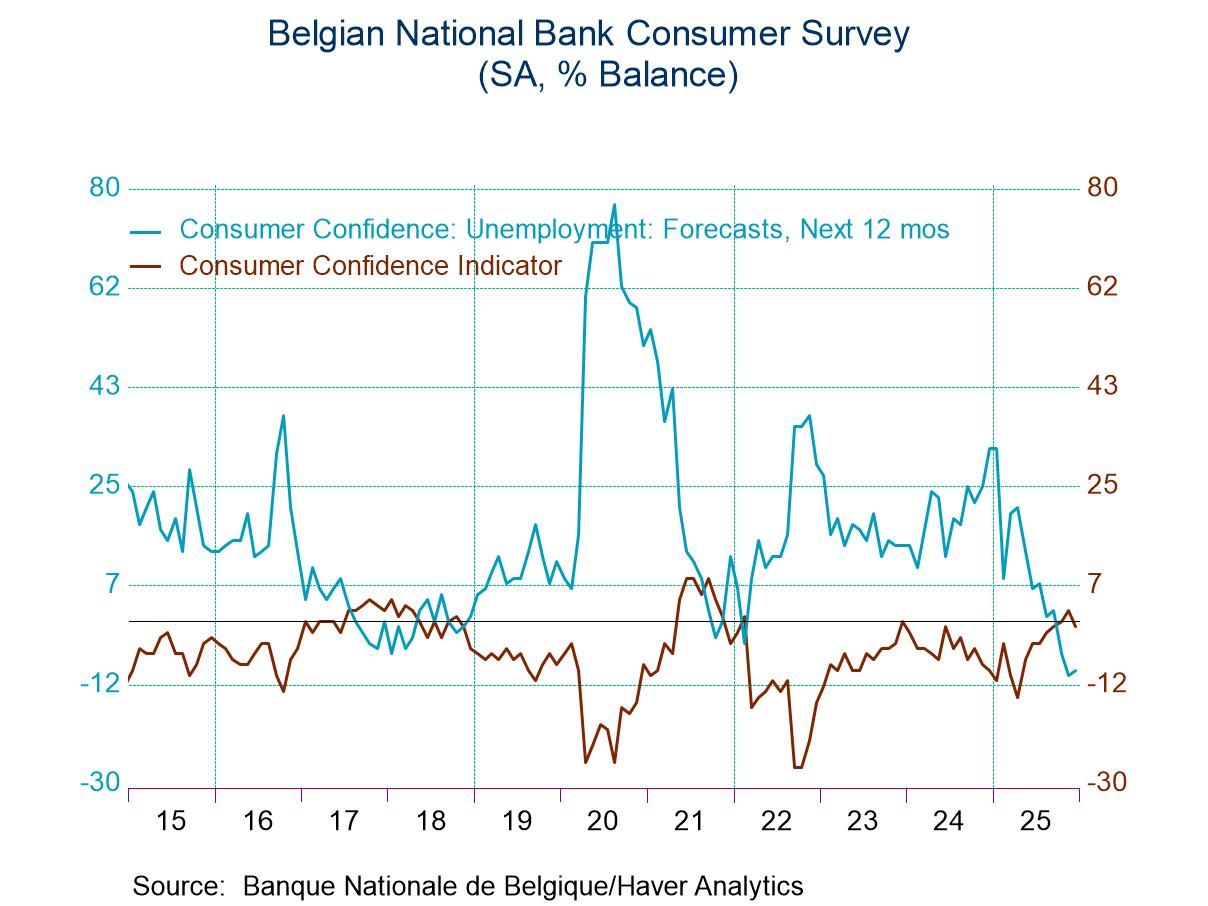 Global| Aug 15 2018
Global| Aug 15 2018U.S. Business Inventory Accumulation Slows
by:Tom Moeller
|in:Economy in Brief
Summary
Total business inventories increased 0.1% (4.0% y/y) during June following two months of 0.3% increase. Total business sales increased 0.3% (8.2% y/y), following a 1.3% gain. The inventory-to-sales ratio rose to 1.35 from 1.34. It [...]
Total business inventories increased 0.1% (4.0% y/y) during June following two months of 0.3% increase. Total business sales increased 0.3% (8.2% y/y), following a 1.3% gain. The inventory-to-sales ratio rose to 1.35 from 1.34. It peaked early in 2016 at 1.43.
Retail inventories increased 0.1% (1.7% y/y) in June, following two months of 0.4% increase. Auto inventories eased 0.1% (+1.2% y/y) after a 0.9% rise. Non-auto retail inventories increased 0.2% (2.0% y/y) following a 0.1% uptick. General merchandise inventories fell 0.3% (-0.5% y/y) after a 0.2% gain. In the department store sector, inventories declined 0.5% (-3.1% y/y) following a 0.2% rise. Building materials inventories surged 1.5% (7.6% y/y) after a 0.5% increase, while clothing store inventories fell 0.2% (-0.7% y/y), down for the fourth straight month. Inventories of furniture, electronics and appliances declined 0.9% (-1.9% y/y), the fifth m/m decline this year. As reported last week, wholesale inventories edged 0.1% higher (5.1% y/y) following a 0.3% rise. Factory sector inventories also rose 0.1% (5.1% y/y) following a 0.2% gain.
Retail sales held steady in June (5.8% y/y) with non-auto sales easing slightly (+6.5% y/y) after a 1.2% jump. Wholesale sector sales slipped 0.1% (+10.2% y/y) after improving 2.1%. Shipments from the factory sector surged 1.0% (8.4% y/y) following a 0.6% rise.
The overall business inventory-to-sales (I/S) ratio rose to 1.35. In the retail sector, the ratio held steady at 1.43 in June, down sharply from the levels averaged during the prior two years. The non-auto I/S ratio was steady at 1.20, its lowest level since early-2012. The ratio peaked at 1.29 early in 2016. The wholesale sector I/S ratio was stable at 1.25, its lowest level since November 2014. The manufacturing sector I/S ratio declined to 1.33, its lowest point in three years.
The manufacturing and trade data are in Haver's USECON database.
| Manufacturing & Trade | Jun | May | Apr | Jun Y/Y | 2017 | 2016 | 2015 |
|---|---|---|---|---|---|---|---|
| Business Inventories (% chg) | 0.1 | 0.3 | 0.3 | 4.0 | 3.5 | 1.8 | 1.7 |
| Retail | 0.1 | 0.4 | 0.4 | 1.7 | 2.4 | 4.1 | 4.9 |
| Retail excl. Motor Vehicles | 0.2 | 0.1 | 0.2 | 2.0 | 2.3 | 1.9 | 3.9 |
| Merchant Wholesalers | 0.1 | 0.3 | 0.1 | 5.1 | 3.6 | 2.2 | 1.2 |
| Manufacturing | 0.1 | 0.2 | 0.4 | 5.1 | 4.5 | -0.7 | -0.8 |
| Business Sales (% chg) | |||||||
| Total | 0.3 | 1.3 | 0.6 | 8.2 | 5.8 | -0.8 | -3.4 |
| Retail | 0.0 | 1.0 | 0.4 | 5.8 | 4.9 | 2.5 | 1.9 |
| Retail excl. Motor Vehicles | -0.0 | 1.2 | 0.5 | 6.5 | 4.9 | 2.0 | 0.4 |
| Merchant Wholesalers | -0.1 | 2.1 | 1.4 | 10.2 | 7.4 | -1.3 | -4.9 |
| Manufacturing | 1.0 | 0.6 | 0.1 | 8.4 | 5.0 | -3.2 | -6.2 |
| I/S Ratio | |||||||
| Total | 1.35 | 1.34 | 1.35 | 1.39 | 1.38 | 1.42 | 1.39 |
| Retail | 1.43 | 1.43 | 1.44 | 1.49 | 1.47 | 1.49 | 1.46 |
| Retail excl. Motor Vehicles | 1.20 | 1.20 | 1.21 | 1.25 | 1.24 | 1.28 | 1.27 |
| Merchant Wholesalers | 1.25 | 1.25 | 1.27 | 1.31 | 1.29 | 1.35 | 1.33 |
| Manufacturing | 1.33 | 1.35 | 1.35 | 1.37 | 1.37 | 1.41 | 1.39 |
Tom Moeller
AuthorMore in Author Profile »Prior to joining Haver Analytics in 2000, Mr. Moeller worked as the Economist at Chancellor Capital Management from 1985 to 1999. There, he developed comprehensive economic forecasts and interpreted economic data for equity and fixed income portfolio managers. Also at Chancellor, Mr. Moeller worked as an equity analyst and was responsible for researching and rating companies in the economically sensitive automobile and housing industries for investment in Chancellor’s equity portfolio. Prior to joining Chancellor, Mr. Moeller was an Economist at Citibank from 1979 to 1984. He also analyzed pricing behavior in the metals industry for the Council on Wage and Price Stability in Washington, D.C. In 1999, Mr. Moeller received the award for most accurate forecast from the Forecasters' Club of New York. From 1990 to 1992 he was President of the New York Association for Business Economists. Mr. Moeller earned an M.B.A. in Finance from Fordham University, where he graduated in 1987. He holds a Bachelor of Arts in Economics from George Washington University.


